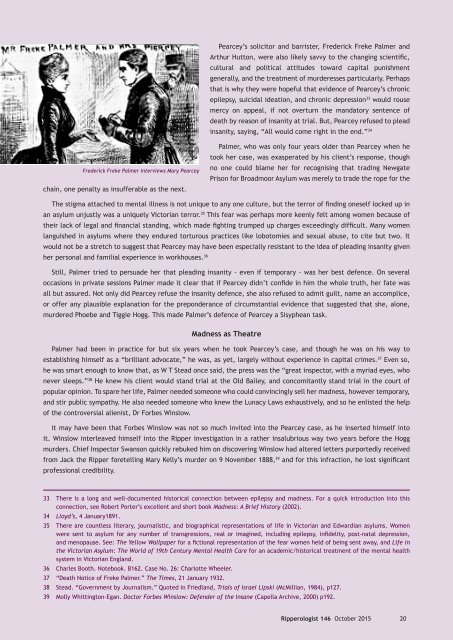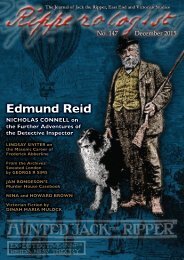GEORGE HUTCHINSON
orxwju5
orxwju5
You also want an ePaper? Increase the reach of your titles
YUMPU automatically turns print PDFs into web optimized ePapers that Google loves.
Pearcey’s solicitor and barrister, Frederick Freke Palmer and<br />
Arthur Hutton, were also likely savvy to the changing scientific,<br />
cultural and political attitudes toward capital punishment<br />
generally, and the treatment of murderesses particularly. Perhaps<br />
that is why they were hopeful that evidence of Pearcey’s chronic<br />
epilepsy, suicidal ideation, and chronic depression 33 would rouse<br />
mercy on appeal, if not overturn the mandatory sentence of<br />
death by reason of insanity at trial. But, Pearcey refused to plead<br />
insanity, saying, “All would come right in the end.” 34<br />
Frederick Freke Palmer interviews Mary Pearcey<br />
chain, one penalty as insufferable as the next.<br />
Palmer, who was only four years older than Pearcey when he<br />
took her case, was exasperated by his client’s response, though<br />
no one could blame her for recognising that trading Newgate<br />
Prison for Broadmoor Asylum was merely to trade the rope for the<br />
The stigma attached to mental illness is not unique to any one culture, but the terror of finding oneself locked up in<br />
an asylum unjustly was a uniquely Victorian terror. 35 This fear was perhaps more keenly felt among women because of<br />
their lack of legal and financial standing, which made fighting trumped up charges exceedingly difficult. Many women<br />
languished in asylums where they endured torturous practices like lobotomies and sexual abuse, to cite but two. It<br />
would not be a stretch to suggest that Pearcey may have been especially resistant to the idea of pleading insanity given<br />
her personal and familial experience in workhouses. 36<br />
Still, Palmer tried to persuade her that pleading insanity - even if temporary - was her best defence. On several<br />
occasions in private sessions Palmer made it clear that if Pearcey didn’t confide in him the whole truth, her fate was<br />
all but assured. Not only did Pearcey refuse the insanity defence, she also refused to admit guilt, name an accomplice,<br />
or offer any plausible explanation for the preponderance of circumstantial evidence that suggested that she, alone,<br />
murdered Phoebe and Tiggie Hogg. This made Palmer’s defence of Pearcey a Sisyphean task.<br />
Madness as Theatre<br />
Palmer had been in practice for but six years when he took Pearcey’s case, and though he was on his way to<br />
establishing himself as a “brilliant advocate,” he was, as yet, largely without experience in capital crimes. 37 Even so,<br />
he was smart enough to know that, as W T Stead once said, the press was the “great inspector, with a myriad eyes, who<br />
never sleeps.” 38 He knew his client would stand trial at the Old Bailey, and concomitantly stand trial in the court of<br />
popular opinion. To spare her life, Palmer needed someone who could convincingly sell her madness, however temporary,<br />
and stir public sympathy. He also needed someone who knew the Lunacy Laws exhaustively, and so he enlisted the help<br />
of the controversial alienist, Dr Forbes Winslow.<br />
It may have been that Forbes Winslow was not so much invited into the Pearcey case, as he inserted himself into<br />
it. Winslow interleaved himself into the Ripper investigation in a rather insalubrious way two years before the Hogg<br />
murders. Chief Inspector Swanson quickly rebuked him on discovering Winslow had altered letters purportedly received<br />
from Jack the Ripper foretelling Mary Kelly’s murder on 9 November 1888, 39 and for this infraction, he lost significant<br />
professional credibility.<br />
33 There is a long and well-documented historical connection between epilepsy and madness. For a quick introduction into this<br />
connection, see Robert Porter’s excellent and short book Madness: A Brief History (2002).<br />
34 Lloyd’s, 4 January1891.<br />
35 There are countless literary, journalistic, and biographical representations of life in Victorian and Edwardian asylums. Women<br />
were sent to asylum for any number of transgressions, real or imagined, including epilepsy, infidelity, post-natal depression,<br />
and menopause. See: The Yellow Wallpaper for a fictional representation of the fear women held of being sent away, and Life in<br />
the Victorian Asylum: The World of 19th Century Mental Health Care for an academic/historical treatment of the mental health<br />
system in Victorian England.<br />
36 Charles Booth. Notebook. B162. Case No. 26: Charlotte Wheeler.<br />
37 “Death Notice of Freke Palmer.” The Times, 21 January 1932.<br />
38 Stead. “Government by Journalism.” Quoted in Friedland, Trials of Israel Lipski (McMillian, 1984), p127.<br />
39 Molly Whittington-Egan. Doctor Forbes Winslow: Defender of the Insane (Capella Archive, 2000) p192.<br />
Ripperologist 146 October 2015 20




